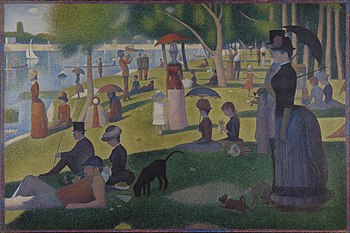Nikola Benin, Ph.D


A Sunday Afternoon on
the Island of La Grande Jatte (French: Un dimanche après-midi à l'Île de la
Grande Jatte) is Georges Seurat's most famous work1.
Seurat painted A Sunday Afternoon between May 1884 and March 1885, and from
October 1885 to May 1886, focusing meticulously on the landscape of the park.
He reworked the original and completed numerous preliminary drawings and oil
sketches2. He sat in the park, creating numerous sketches of the
various figures in order to perfect their form.
The painting was first exhibited at the eighth (and last)
Impressionist exhibition in May 1886, then in August 1886, dominating the
second Salon of the Société des Artistes Indépendants, of which Seurat had been a founder in 1884.
Inspired by research in optical and color theory, he
juxtaposed tiny dabs of colors that, through optical blending, form a single
and, he believed, more brilliantly luminous hue. He believed that this form of
painting, called Divisionism at the time (a term he preferred) but now known as
Pointillism, would make the colors more brilliant and powerful than standard
brushstrokes. The use of dots of almost uniform size came in the second year of
his work on the painting, 1885–86. To make the experience of the painting even
more intense, he surrounded the canvas with a frame of painted dashes and dots,
which he, in turn, enclosed with a pure white wood frame, similar to the one
with which the painting is exhibited today. The very immobility of the figures
and the shadows they cast makes them forever silent and enigmatic.
Bathers at Asnières, completed shortly before, in
1884. Whereas the bathers in that earlier painting are doused in light, almost
every figure on La Grande Jatte appears to be cast in shadow, either under
trees or an umbrella, or from another person. For Parisians, Sunday was the day
to escape the heat of the city and head for the shade of the trees and the cool
breezes that came off the river. And at first glance, the viewer sees many
different people relaxing in a park by the river. On the right, a fashionable
couple, the woman with the sunshade and the man in his top hat, are on a
stroll. On the left, another woman who is also well dressed extends her fishing
pole over the water. There is a small man with the black hat and thin cane
looking at the river, and a white dog with a brown head, a woman knitting, a
man playing a horn, two soldiers standing at attention as the musician plays,
and a woman hunched under an orange umbrella. Seurat also painted a man with a
pipe, a woman under a parasol in a boat filled with rowers, and a couple
admiring their infant child3.
Some of the characters are doing curious things. The
lady on the right side has a monkey on a leash. A lady on the left near the
river bank is fishing. The area was known at the time as being a place to procure
prostitutes among the bourgeoisie, a likely allusion of the otherwise odd
"fishing" rod. In the painting's center stands a little girl dressed
in white (who is not in a shadow), who stares directly at the viewer of the
painting. This may be interpreted as someone who is silently questioning the
audience: "What will become of these people and their class?" Seurat
paints their prospects bleakly, cloaked as they are in shadow and suspicion of
sin4.
In the 1950s, historian and Marxist philosopher Ernst Bloch
drew social and political significance from Seurat's La Grande Jatte. The
historian's focal point was Seurat's mechanical use of the figures and what
their static nature said about French society at the time. Afterward, the work
received heavy criticism by many that centered on the artist's mathematical and
robotic interpretation of modernity in Paris5.
According to historian of Modernism William R.
Everdell:
Seurat himself told a sympathetic critic, Gustave
Kahn, that his model was the Panathenaic procession in the Parthenon frieze.
But Seurat didn't want to paint ancient Athenians. He wanted 'to make the
moderns file past ... in their essential form.' By 'moderns' he meant nothing
very complicated. He wanted ordinary people as his subject, and ordinary life.
He was a bit of a democract—a "Communard," as one of his friends
remarked, referring to the left-wing revolutionaries of 1871; and he was
fascinated by the way things distinct and different encountered each other: the
city and the country, the farm and the factory, the bourgeois and the
proletarian meeting at their edges in a sort of harmony of opposites6.
The border of the painting is, unusually, in inverted
color, as if the world around them is also slowly inverting from the way of
life they have known. Seen in this context, the boy who bathes on the other
side of the river bank at Asnières appears to be calling out to them, as if to
say, "We are the future. Come and join us".
References
1. Kathryn Calley Galitz (2007). Masterpieces of
European Painting, 1800–1920, in the Metropolitan Museum of Art. Metropolitan
Museum of Art (New York, N.Y.). p. 177.
2. H. Dorra and J. Rewald, Seurat, Paris, 1960, p.
156.
3. Burleigh, Robert, Seurat and La Grande Jatte:
connecting the dots, New York: H.N. Abrams in association with the Art
Institute of Chicago, 2004. Print.
4. BBC, The Private Life of a Masterpiece (2005)
Series 4, Georges Seurat: A Sunday Afternoon on the Island of La Grande Jatte.
5. New York Times, Fire in Modern Museum; Most Art
Safe; 6 Canvases Burned, Seurat's Removed, 16 April 1958.
6. William R. Everdell, The First Moderns: Profiles in
the Origins of Twentieth Century Thought (Chicago: University of Chicago
Press), 66-7.
Няма коментари:
Публикуване на коментар